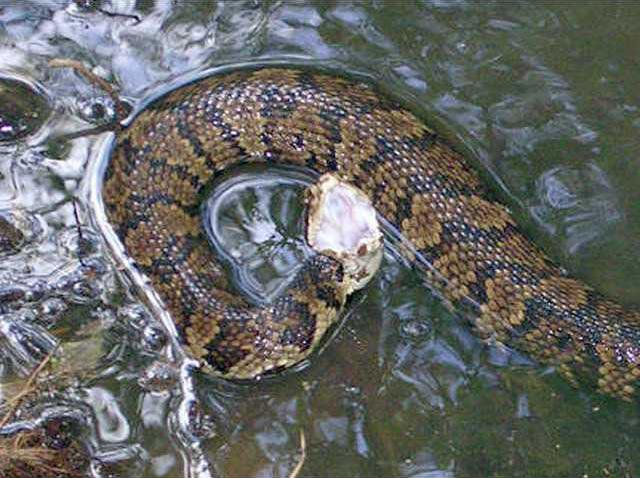“Snake!” It’s one of those exclamatory words that cause some people to panic. Some people freeze instantly, afraid to take another step, while others begin a series of steps that look like they’re auditioning for Riverdance. Nonetheless, as temperatures get warmer and flora and fauna show signs of spring in Coastal Georgia, encounters with snakes are common.
John Jensen of the Georgia Department of Natural Resources said people really don’t have to worry about snakes, although he suggests they take the time to learn which snakes are venomous and avoid direct contact with all snakes.
“We have 45 species of snakes in the state,” said Jensen, a wildlife biologist and reptile expert. “Only six of them are venomous. It’s too bad most people won’t take the time to distinguish venomous snakes from non-venomous ones.”
Jensen said the six venomous snakes common to this region of Georgia include three species of rattlesnakes: the Eastern diamondback rattlesnake, timber or canebrake rattlesnake and pigmy rattlesnake. There also are the copperhead, cottonmouth moccasin and coral snakes, he said. If a snake has rattles, it’s a rattlesnake. If it has “Hershey’s Kisses” or reddish-brown hourglass shapes on its body, it’s probably a copperhead. If it has red, yellow and black bands with a black head, it’s a coral snake.
Jensen said snakes in Georgia are less active during the winter months, although it’s not uncommon to see one basking in the sun on a wintry day. Because snakes are cold-blooded, their body temperature is regulated by the outside temperature, he said. He said copperheads and rattlesnakes are common in dryer areas, cottonmouths are more common in swampy areas, and coral snakes are rarely seen at all.
Jensen explained that snake venom is either hemotoxic or neurotoxic. Most rattlesnakes and all copperheads and cottonmouths have hemotoxic venom, which, he said, can be treated by CorFab anti-venom. Coral snakes have neurotoxic venom, but coral snake bites are very rare, he said. Although they don’t grow as big as the diamond back, the venom of some timber rattlers found in South Carolina and Georgia show both hemotoxic and neurotoxic components.
According to www.cottonmouthsnake.org, hemotoxic venom attacks the blood and tissue cells, sometimes causing traumatic tissue damage but rarely death. The website said neurotoxic venom attacks the central nervous system and brain, and can cause paralysis and necrosis (killing of tissue cells), which can lead to amputation and sometimes death.
Jensen said some common non-venomous snakes in this area include yellow rat snakes, black racers, brown water snakes, hognose snakes, rough green snakes and garter snakes (sometimes confused with glass snakes, which actually are legless lizards). He said the Eastern indigo snake and Eastern coach whip have become threatened species due to habitat loss. Fort Stewart is one area they’re both still found.
“Habitat loss is affecting some species of snakes,” Jensen said. “They’re not like birds or larger mammals that can move to other areas when their habitat disappears. When snakes’ habitat disappears, so do many snakes. However, some snakes’ populations, like black racers, are increasing because of increasing habitat. They like large, open areas.”
Jensen said it is not necessary to kill a snake, even if it is venomous. Just leave it alone, and it’ll leave you alone. Even the cottonmouth, which once had a nasty reputation as being aggressive, has proven to be no threat, he said. Numerous studies on these snakes have found they only appear aggressive because they’re often seen with their jaws open, displaying their “cotton” mouths. This simply is a warning, like the rattle of a rattlesnake, he said. Jensen added that a cottonmouth will not hesitate to continue its pursuit if a person is standing near its projected food target, like a pond frog hidden near the water’s edge.
The reptile expert said it’s a shame that some non-venomous snakes are confused with venomous snakes and are killed because of mistaken identity. Some hognose snakes, for example, display a color pattern similar to the Southern copperhead.
Jensen emphasized non-venomous snakes are protected in Georgia. He added that snakes shouldn’t be killed anyway because they help control rodent populations.
Look out for snakes
Spring sighting of reptiles most common


Sign up for our e-newsletters